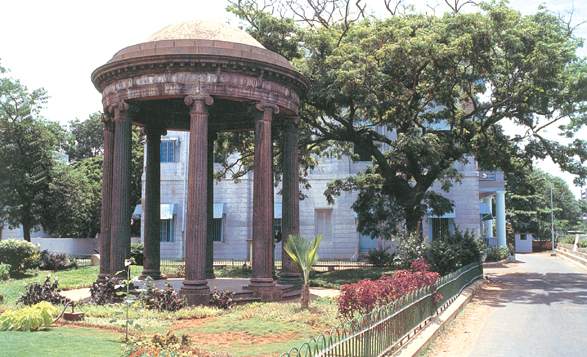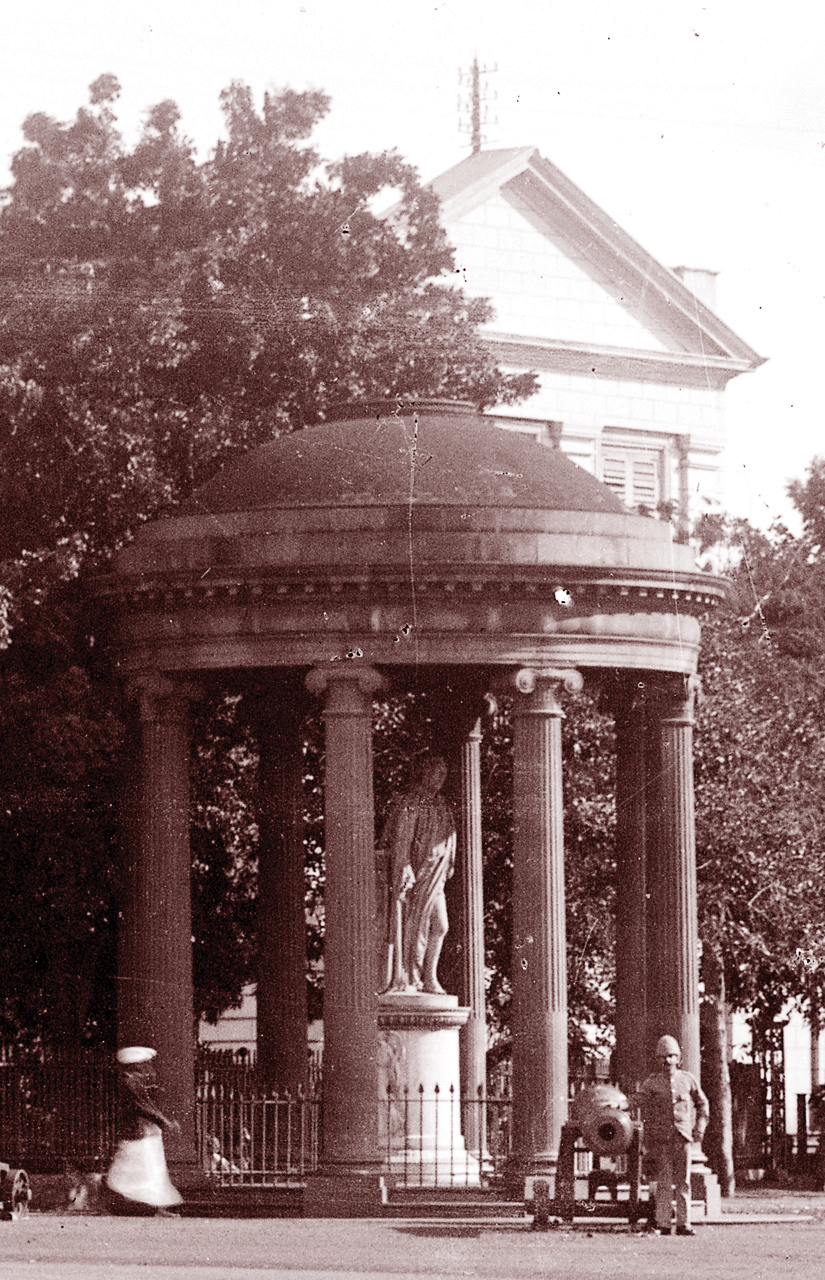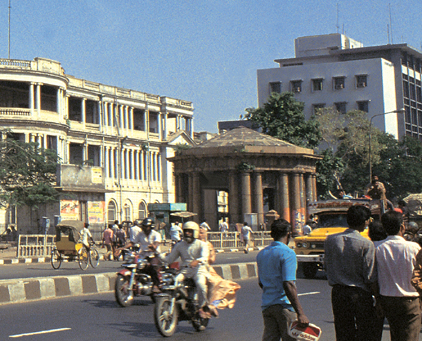|

The Cupola in the Fort, as seen today.
l If you are not a VIP, you enter the Fort through a small side entrance – not for you the joy of sweeping up the driveway in your car, which is perhaps a good thing as there is hardly any parking space in the Fort. You are better off leaving your vehicle in the vast car park opposite the Fort, crossing the road and then queuing up at the side gate. You will need to enter your name, address and phone number in a shabby register and subject yourself to the mandatory metal detector and baggage scanner. And then you are on your own, inside the Fort.
Almost the first thing that strikes your eye is a Greek-styled pavilion. In essence it is an Ionic-pillared rotunda surmounted by a cupola. This stands all by itself in a grassy plot that also has a shade-giving tree. The only thing missing is the centrepiece and that is a huge marble statue of Lord Cornwallis that is now within the Fort Museum, which is to your right as you gaze at the rotunda. Between the two of them, the statue and the pavilion have quite a bit of history, going back 200 years or so.

Cornwallis in his cupola at Parade Square in the Fort.
(Courtesy: Vintage Vignettes)
Cornwallis was Governor-General of India twice, the first tenure being from 1786 to 1793. During that period he achieved what was till then considered impossible – the subduing of Tippu Sultan. Assuming direct command over the operations in 1792, he defeated the Tiger of Mysore. Unlike Lord Wellesley in 1799, he had always made it clear that his intention was never the elimination of Tippu and so imposed severe terms for peace. These included, among other things, an indemnity of Rs. 6 crore (later reduced to Rs. 3.3 crore), and the handing over of two of his three eldest sons as hostages for the due performance of the terms.
The princes were given two residences – Paul Benfield's house in the Fort and the other on the Great Choultry Plain – and remained in Madras till 1794 by when Tippu had paid up in full. In the meanwhile, given that he had achieved an impossible task, the official and unofficial European inhabitants of Madras, started a fund-raising drive to erect a suitable memorial for Cornwallis, to be housed in the Fort. By then he had returned to Calcutta. A year later he resigned from the post of Governor-General and sailed home.
The subscription for the memorial was remitted to England and, to quote from Sir Charles Lawson's Memories of Madras (1905), "someone there was authorised to negotiate with a sculptor for the production of a statue of his Lordship. Then it was that the services of Thomas Banks were enlisted…(He was) the first of his country to produce works of classic grace." Those who visited the studio when the statue was being sculpted were amazed at the resemblance to its original, to the smallest detail, including "the outward cast of one eye in such startling detail." To this Banks retorted that the "eyes looking to the right and left at the same moment would impart the idea of an enlarged and comprehensive mind." A few generations later, we would dismiss the Governor-General as being pop-eyed.
The pedestal of the statue, also sculpted by Banks, has the figures of Britannia and Victory flanking a bas-relief of the definitive moment when Cornwallis received the two boys as hostage. An inscription at the base reads that the statue was erected "by a General Vote at the Joint Expense Of the Principal Inhabitants of Madras, and of the Civil and Military Servants of the East India Company Belonging to the Presidency of Fort St George As a General Testimony Of the High Sense they entertain of the Conduct and Actions of the Most Noble The Marquis of Cornwallis During the Time he held the High Offices of Governor General and Commander In Chief of All the Forces in India."
The statue arrived in Madras in 1800. According to Mary Ann Steggles, in her book Statues of the Raj (2000), "The marble portrait statue of Cornwallis for Madras was the first publicly erected monument exported to India." Early in May that year, M. Turing, Aide-de-Camp to Governor Lord Clive, bade the principal inhabitants of Madras to be present at 5.45 am on the 15th for the unveiling of the statue. A breakfast was arranged at the Exchange Building for all the invitees. The statue was placed under this cupola, located then at the Parade Square of the Fort, and unveiled by the Governor, after which the assembled troops presented arms, the drums beat a march and a salute of honour was fired. "The attendance of ladies and gentlemen, as well on the parade as in the houses, balconies and terraces of the square was," according to the Asiatic Register, "unusually numerous and the concourse of natives was proportionally great." Parade Square was ceremonially renamed Cornwallis Square.
The statue remained within the cupola long enough to be seen by Cornwallis himself. This happened in 1805, when in an "unwise moment" having again accepted the offer of a Governor-Generalship, he embarked on the HMS Medusa and arrived in Madras en route to Calcutta. Here the Governor Lord William Bentinck received him on May 6. The troops formed a ceremonial carriageway from the Sea Gate to Parade Square where an address bearing the signatures of 214 principal residents of Madras was presented to him. In response, Cornwallis made a speech, according to Lawson, "probably in front of the statue of himself that then occupied as it still does, the most important place on the parade ground of Fort St George." This probably gave rise to a subsequent legend, quoted in full in Nirmala Lakshman's Degree Coffee by the Yard, that Cornwallis was present in Madras to welcome his statue in honour of which he organised a grand parade and during which he saluted his own image.

The Cenotaph opposite Bentinck's Building on North Beach
Road (Rajaji Salai).
The ceremony over, Cornwallis departed for Bengal. He died on October 5th the following year of "Bengal liver" at Ghazipore and was buried there as per his dictum, "Where the tree falls, let it lie." The news of his passing reached Madras on the 31st. On November 5th, at the instance of the Sheriff of Madras, John Oakes, a meeting was held at the Exchange Building of the Fort to consider "proper measures for erecting a Cenotaph" to commemorate Cornwallis. The resolution was adopted, a long list of subscribers gave in plenty and, shortly thereafter, a large rotunda topped by a Burmese pagoda-like super-structure was erected in Teynampet, then the city boundary. The road that led from it to Adyar became Cenotaph Road. Lawson does not, however, mention that the statue moved to the Cenotaph and when he wrote his book in 1905, it was still at Parade Square in the Fort.
The Cenotaph itself was, however, shifted. By the 1880s it had moved to First Line Beach, "opposite the Presidency Post Office" according to Lawson. This gives rise to some confusion as it is now located not opposite the post office but in the compound of what was Bentinck's Building, then the Supreme Court (and from 1862 till 1892 the High Court) of Madras, which was demolished in the 1980s to make way for the Singaravelar Maligai, the Chennai Collectorate. Did the harbour works of the 1880s necessitate one more shift of the Cenotaph within First Line Beach? Or was Lawson's memory playing tricks? Photographs from the 1880s show the Cenotaph as it stands today.
In 1925, the Cornwallis statue moved out of Parade Square to the Cenotaph. It stayed there for just three years, moving in 1928 to the Connemara Library as the salt and moisture-laden air of the sea at First Line Beach began attacking the marble. The statue remained in the library till 1950, when it made its last journey, this time to the Fort Museum. The cupola in Parade Square remained where it was till 1935 when, at the orders of the then Governor, Lord Erskine, it was shifted to where it stands now. The Cenotaph on First Line Beach remains where it was, an empty shell now doubling up as a convenient urinal.
- Sriram V.
|

